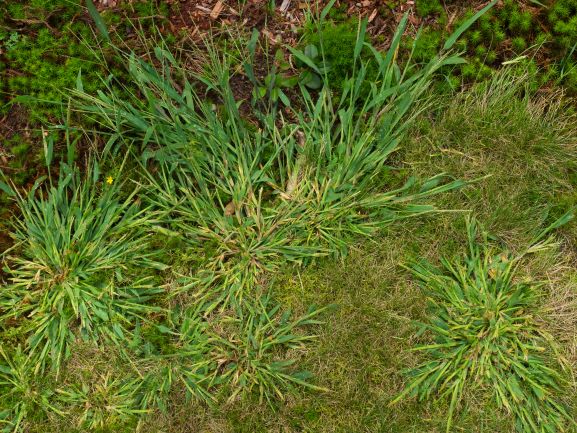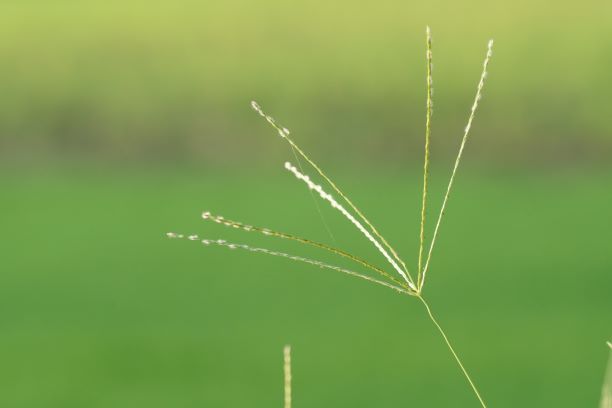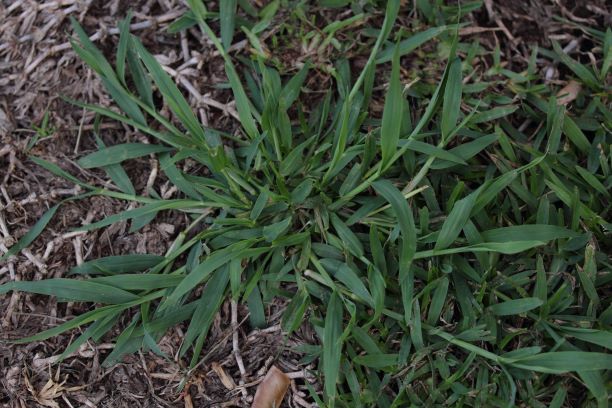Crabgrass

Crabgrass (Digitaria spp.) is a true annual grassy weed found in lawns and turf in much of the United States. Smooth crabgrass (Digitaria ischaemum) and large crabgrass (Digitaria sanguinalis) are the most common crabgrass species. Crabgrass has lime green, coarse-textured leaves and a rolled stem. It typically has a prostrate growth habit, spreading out along the ground. Crabgrass seedheads appear finger-like, arising from different points at the top of the stem. The leaves and leaf sheaths of large crabgrass are typically covered in dense hairs while those of smooth crabgrass are hairless and purple at the base. In the northeastern U.S., smooth crabgrass tends to be more prevalent than large crabgrass.

Crabgrass seeds germinate in the spring and seedlings grow rapidly throughout the summer. Mature plants in late summer will produce seed before dying after the first frost in autumn. Each plant can produce thousands of seeds that remain viable in the soil for up to several years, making this annual weed a significant problem in multiple years. A dense stand of turfgrass is the most effective way to prevent and minimize crabgrass. Adequate nitrogen fertility should be applied, particularly in the spring and fall when desirable cool-season grasses grow more vigorously than crabgrass. Research has shown that mowing at the highest recommended height for your particular turfgrass species will also significantly reduce crabgrass infestations when compared to a low mowing height.

Pre-emergence herbicides are more generally more effective and economical for crabgrass control than post-emergence herbicides. They are also widely available in combination with an appropriate spring fertilizer. Pre-emergence herbicides should be applied and watered into the soil before crabgrass germinates, so timing is important. The best way to judge the proper timing of application is by monitoring local soil temperature, which can easily be measured or found online. Crabgrass seeds germinate at a soil temperature of 55 degrees F. – and the pre-emergence herbicide should be applied before this soil temperature is reached. This is generally in the April timeframe but can vary. Most pre-emergent herbicides will not control crabgrass after it germinates. The length of control is also important – to control late summer crabgrass germination. So don’t apply the pre-emergence herbicide too early.
Pre-emergent herbicides should be applied to well-established, mature turfgrass. Do not apply the pre-emergence herbicides listed below if you plan to seed several weeks after the application, as most of these herbicides can kill turfgrass seed. (Note: mesotrione is an exception to this limitation.) See the specific product label for more information on use before or after seeding, even if seeding was conducted the previous autumn.
LebanonTurf® offers several herbicide products that are labeled for pre-emergence control of crabgrass, including the following:
ProScape 16-0-8 43% MESA .43 Barricade
ProScape 15-0-5 40% MESA .15 Dimension
Lebanon Pro 20-0-4 30% LSN .86 Pendimethalin
Lebanon Team 2G Biodac Herbicide
ProScape 21-22-4 Starter Fertilizer With .08 Mesotrione
Other options can be found in our weed control product section.
All products are applied with a dry granule spreader. Products are generally applied in the spring (see discussion of soil temperature above) or late fall (for the following season). Follow all specific label directions when using these products.
LebanonTurf is a registered trademark of Lebanon Seaboard Corporation
Barricade is a registered trademark of a Syngenta Group Company
Dimension is a registered trademark of Dow AgroSciences
Team is a registered trademark of Gowan Company